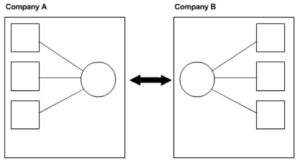October 5, 2016
Alliance Framework
Based upon Gene Slowinski and The Alliance Management Group
www.strategicalliance.com/Bio_Slowinski.htm
Open Innovation is necessary to achieve success during early stage technology commercialization.
* How to implement the “want, find, get, and manage model”
- You have to know what you want, then how to you find it, then how do you get it contractually and then how to manage it to success.
How do you structure a relationship between two firms (or two individuals) to be successful?
Alliance Framework (gold standard for planning/structuring a deal).

Define your success as:
- Get to an agreement that is profitably implemented or
- Walk away as friends without reaching a bad agreement
** disengage quickly if you realize that this is a bad deal.- 8 weeks to know you will not do a deal
- Implementers (and champions) are part of the planning process. –
- Determine how and why alliances can go bad.
Failures of alliance success:
- It is unclear whether internal parties are aligned.
- Mismanagement and lack of communication between parties:
- Create go/no-go decision points:
- Internal, alliance framework will be put together by a team and will present your view of the deal. Every functional head will have the opportunity to make comments on the deal structure. Can I get one deal structure out of this?
- Presentation to external company: We can move forward with the deal, we cannot move forward with this at all, or we agree enough to negotiate the rest of the agreement
- Create go/no-go decision points:
Internal discussions to determine future success of the alliance:
- Objectives (ours, theirs)
- Roles (ours, theirs) – Overall resources
- Boundaries
- Strategic exclusivity – Market model
- Intersections with the potential alliance
Move forward if you are aligned strategically (above)
- Business plan summary
- Detailed objectives
- Detailed resources
- Financial pie-split
- IP
- Working process and governance
- Term and termination
- Alliance structure
Process: The alliance framework is a 6-step process:
- Appointing the planning and negotiating team: Line manager as leader (champion) & other managers (those that are committing resources), lawyer (IP and contract person), implementer, BD
- Achieving internal consensus (Kill point #1): Internal alliance framework drafts with stakeholder inputs and senior management signoff. Typically takes 3-4 major iterations
OBJECTIVES: Tied tightly to business intents, expressed as specifically as possible:
“#1 in customer service” is not an objective. “I am interested in acquiring company X’s technology in the field of use for animal use globally…” is an objective.
ROLES and OVERALL RESOURCES: Who does what? Who brings what? Who has the final vote…?
BOUNDARIES:
** As long as company B was using background IP in overlapping area, company A is good. However, company B used the IP in point 1, which turned out to be a strategic area for company A and company B beat them to it… not acceptable for company A, or the alliance.
Possible dimension for boundary definition:
- Technology platforms
- Products, product classes
- Manufacturing processes
** Be careful with too narrow or too broadly boundaries
STRATEGIC EXCLUSIVITY
- Can either have an overlapping alliance
- Can either “do it yourself”
- Carveouts?
- What are the risks in an “exclusive” alliance?
MARKET MODEL
- Branding other marketing communications, channel partners, distribution
INTERSECTIONS
- What existing relationships may impact on the prospective alliance?
- Overlapping R&D relationships, commitments to channel partners andconstraints on IP
Step 3: Approaching potential partners (assessment of strategic fit)
Step 4: Resource fit assessment (“Tire kicks”)
Step 5: Selecting the partner (once diligence and tire kicks are complete and it looks like we are doing something together).
- May have been communicating with multiple – you have to pick one. The others have to know and why? You will also need to have identified people/resources that you will need to go and find.
Step 6: Negotiating an agreement
- 99% of the negotiation work has been done by the time you get there
- Look for win-win-lose-lose
Now get started on putting together the framework to make the alliance successful:
- Business plan summary, as complete as you can make. Let the stakeholders know that you will be updating the BP as you go along
- Detailed objectives and detailed resources. Include period from intial development through early commercialization. Best joint assessment … even with imperfect knowledge
- Working process and governance
- Financial pie split
- IP
- Term and termination, expected term and renewal conditions/breach/residuals? End book
** Seamless transition from negotiation to implementation: important predictors
The toughest issues in alliances are – “how do we deal with each other when things don’t go according to our fondest expectations”
- There are additional resources on Gene’s website (listed above).